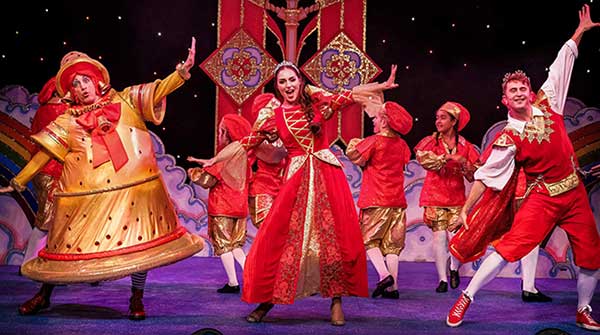The entertainment imperative trumps ‘authenticity’ every time
 People raised in North America aren’t usually exposed to the phenomenon of the Christmas pantomime. Some might even think it has something to do with mime, which it most assuredly doesn’t.
People raised in North America aren’t usually exposed to the phenomenon of the Christmas pantomime. Some might even think it has something to do with mime, which it most assuredly doesn’t.
But those who grew up in Britain or Ireland will have an entirely different perspective. Pantomime – panto for short – is an integral part of the season there. And although primarily conceived for children, adults can also have a good time. A very good time, in fact.
Pantos are usually based on well-known children’s stories. The likes of Cinderella, Aladdin, Snow White and Puss in Boots have been endlessly recycled and refurbished.
And there’s no requirement to stick to the details of the original story. Panto is a form where the entertainment imperative trumps ‘authenticity’ every time. It’s all about having fun.
Sometimes this involves introducing known characters from other stories. Other times it’s a matter of pure invention.
Panto operates on two levels, one for the children and one for the adults. Whereas children are attracted to the characters and plot lines derived or adapted from the original stories, adults are treated to topical jokes and mild double entendre. The risqué bits pass over the children’s heads, or at least that’s the theory.
Music, too, is a significant component.
This can be simply a question of importing already popular songs and maybe tweaking the lyrics to provide topicality. Or it can involve custom-written material.
A spectacular example of the latter would be the lavish mid-1960s London Palladium pantos starring English singer Cliff Richard. Decked out with completely original scores, they were musical extravaganzas that ran from Christmas to Easter.
But perhaps the most distinguishing feature of the panto is audience participation. You might even call it an essential element.
The villain must be booed – and I don’t mean tentatively.
Advice must also be proffered. When the villain creeps up behind some unsuspecting innocent, it’s appropriate to shout out a warning. “Look behind you” is a popular formulation.
And let’s not forget the casting oddities.
The male lead is often played by a woman dressed as a man. And there’s an older female character – the dame – who is invariably played by a man in drag. You might consider it a mainstream manifestation of cross-dressing!
As a child in early 1950s Dublin, I had a couple of panto experiences. Both were at the long-demolished Theatre Royal.
Stylishly art deco, the theatre had a capacity of 4,000 (3,700 seated and 300 standing). This made it one of Europe’s largest venues and an aspirational destination for Dubliners looking for a special evening out.
My first panto excursion was to see Robinson Crusoe, which was based on Daniel Defoe’s 1719 novel about shipwreck, survival and eventual rescue. Or, to be more accurate, it was inspired by Defoe’s story.
The inspiration, mind you, was loose – make that very loose.
To fill the villain role, Captain Hook was imported from Peter Pan and duly described as “a bad, bad pirate.” And for the dame slot, Crusoe’s mother was parachuted in as “a merry widow.”
But while both Defoe and his literary protagonist were English, the Theatre Royal production injected a note of local patriotism. The good ship Irish Clipper travelled to Neptune’s Domain and the Island of Golden Palms, thereby permitting Crusoe’s mother to discover the Lollipop Tree.
Absolute nonsense, of course – but good fun.
My other panto came a couple of years later in the form of Babes in the Wood, which derives its source material from the late-16th-century English story. The original is a tragedy.
Two small orphans are left in the care of an uncle and aunt. However, the uncle is a nasty piece of work who covets their inheritance. Ultimately, they die from exposure after being abandoned in the woods and the birds cover their dead bodies with leaves.
Obviously, something needs to be done to convert this to suitable panto material and various strategies have been deployed, including injecting Robin Hood into the narrative. Alas, I’ve no memory of how the 1953 Royal production handled the dilemma.
If you’ve never experienced panto, give yourself a treat should the opportunity ever arise. And don’t worry about having to sort the good folks from the bad. Panto doesn’t traffic in subtlety.
So when the villain appears, hiss – and make it loud.
Pat Murphy casts a history buff’s eye at the goings-on in our world. Never cynical – well, perhaps a little bit.
For interview requests, click here.
The opinions expressed by our columnists and contributors are theirs alone and do not inherently or expressly reflect the views of our publication.
© Troy Media
Troy Media is an editorial content provider to media outlets and its own hosted community news outlets across Canada.

